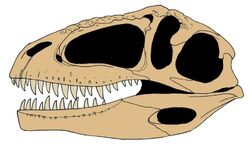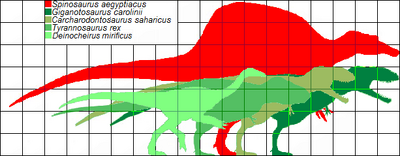| Giganotosaurus | |
|---|---|
 Skull drawing of Giganotosaurus. | |
|
Classification |
Dinosaur; Theropod; Allosauroid; Carcharodontosaurid; Giganotosaurus |
|
Species |
G. carolinii |
|
Name Means |
Giant southern lizard |
|
Pronunciation |
JIG-an-OH-tow-SORE-uss |
|
Weight |
|
|
Height |
|
|
Length |
|
|
Timespan |
104-97 mya |
|
Location |
South America |
|
Diet |
Carnivorous; hunter and scavenger |
Giganotosaurus (pronounced "JYE-ga-NO-toe-SORE-us") is a genus of carcharodontosaurid dinosaur that lived around 97 million years ago during the early Cenomanian stage of the Late Cretaceous Period.[2] It is one of the largest known terrestrial carnivores, maybe comparable of slighty larger than Tyrannosaurus. Its fossils have been found in Argentina.
Discovery And Species[]
Giganotosaurus carolinii was named for Ruben Carolini, an amateur fossil hunter who, in 1993, discovered the fossils in deposits of Patagonia (southern Argentina) in what is now considered the Candeleros Formation. It was published by Rodolfo Coria and Leonardo Salgado in the journal Nature in 1995.
The holotype specimen's (MUCPv-Ch1) skeleton was about 70% complete and included the skull, pelvis, leg bones and most of the backbone. Various estimates find that it measured somewhere between 12.2 and 12.5 m (40 and 41 ft) in length, and between 5 and 8 tonnes in weight. Therrien and Henderson estimated the total length of 13 m (42.6 ft) and mass of 13.8 tonnes, based on skull/body length of various theropods. The skull length of type specimen is estimated of 153 cm or 156 cm. A second, more fragmentary, specimen (MUCPv-95) has also been recovered. It is only known from a portion of the left dentary which is 8% larger than the equivalent bone from the holotype.
Size[]
Its discovery caused a massive hype leading many to call it larger than Sue the Tyrannosaurus. However, it was not as large as people made it out to be. Type specimen measuring 12.2-12.5 m long and probally around 5 to 8 tonnes in weight, it was around in the same length but slightly lighter than Sue and perhaps comparable in mass to some adult specimens of Tyrannosaurus. MUCPv-95 may be perhaps bigger. However, not all estimates are this low. The method of estimating masses from the femur length gives a very different mass. Based on this, Carcharodontosaurus would weigh in the region of 8 tonnes, and since the largest Giganotosaurus specimen would likely have femur as long as this particular Carchardontosaurus specimen. Carcharodontosaurids relatively average build and quite airy bones (comparable to Tyrannosaurus) cast some doubt on these higher figures based on femur length alone.

Giganotosaurus based on the femur length method of estimating masses compared to other theropods.
The partial skull material (specimen MUCPv-95) that was the length has been estimated by Mickey Mortimer to be 13.5 m long, though she later changed his estimate to 13.2 m long assuming that this specimen was around 8 % larger than holotype based on estimates by Coria and Currie, who have re-estimated the Holotype's length at 12.2m long. Mortimer stated 5 t in weight. Coria and Currie described another theropod, Mapusaurus, which is close related to Giganotosaurus. The largest specimens may be comparable in size to Giganotosaurus. Though gave no mass estimates for them. Despite the fact that it isnt as large as the media makes it out to be, it is still one of the largest Theropods known.
Hunting[]
A close relative of Giganotosaurus, Mapusaurus, has been discovered asociating with other members of its own species. This suggests that the animal lived or possibly hunted in groups. Like Mapusaurus, Giganotosaurus may have lived in groups; however there is currently no evidence for this.
Whether it was a solitary hunter or a pack hunter, Giganotosaurus would have been a fearsome killer. Its jaws, like those of Carcharodontosaurus, were scissor-shaped and contained many shark-like teeth, which would have been perfect for ripping through flesh. Its jaws, while powerful, would not have been alble to crunch through bone; instead Giganotosaurus would have sliced the flesh of its prey. In fact, it was perfectly adapted to do this. Assuming it had the same jaw opening capabilities as Allosaurus (while in all probability, it had greater), it would have been able to open its mouth to over 2.5m.[1]
References[]
- ↑ Jaw opening potential of the south american Theropod Giganotosaurus (2009), Big Al, Widest gape of all Theropods